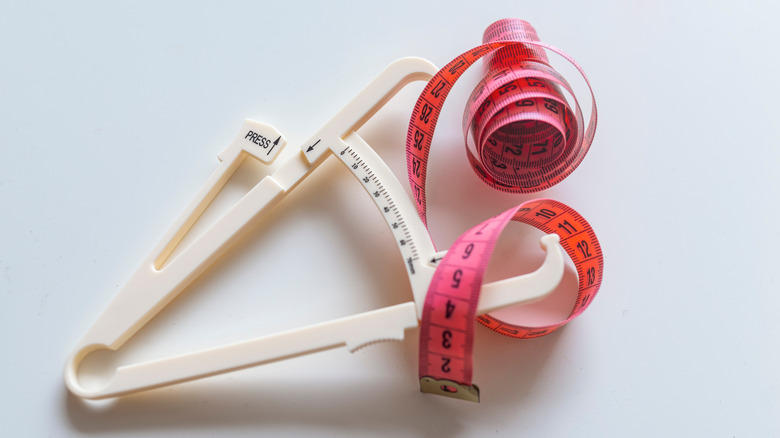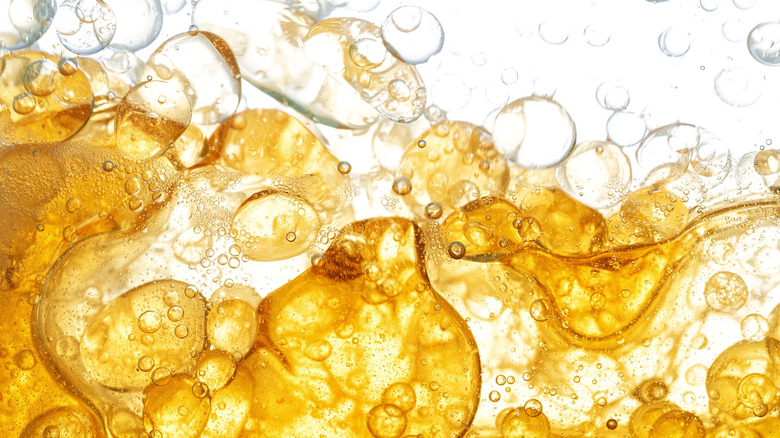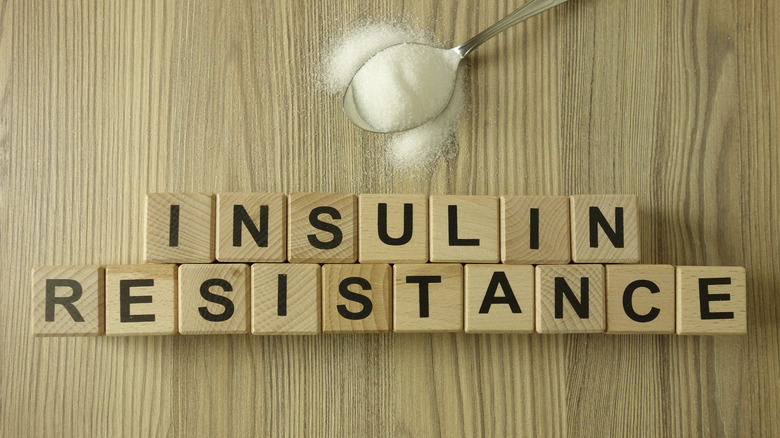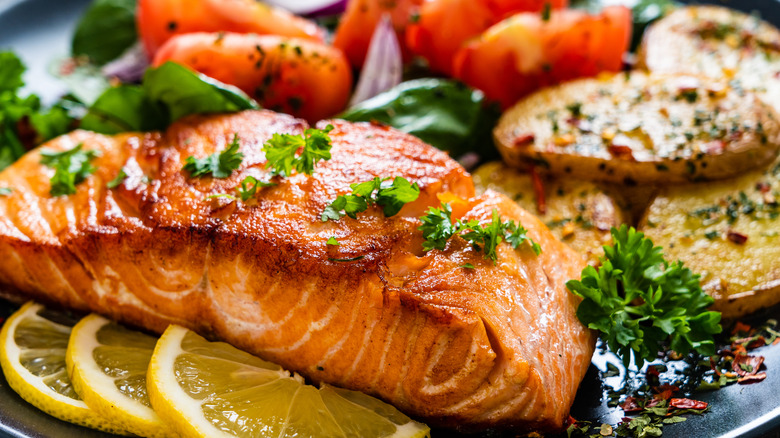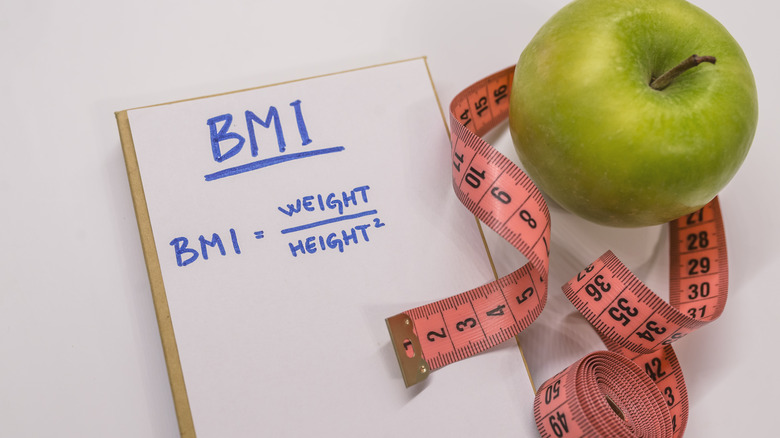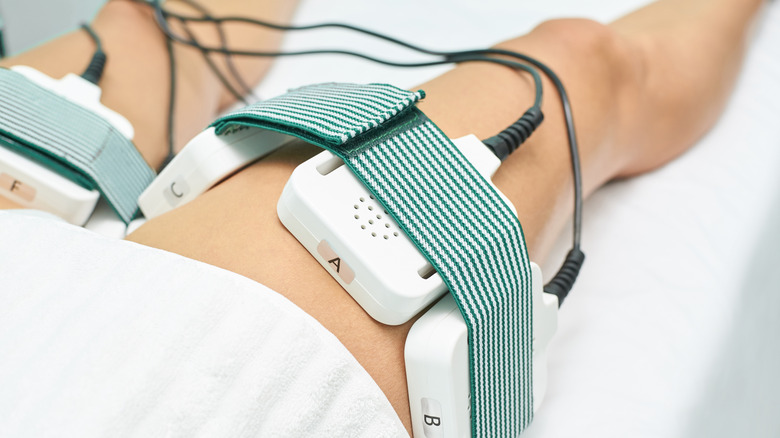Everything You Need To Know About Body Fat
Whether you love, hate, or are simply indifferent to your body fat, it's a complex and sophisticated part of the human anatomy that requires some understanding. Without stored fat, humans would not survive — your brain needs it, as does the rest of your body. Body fat also provides warmth and protects our vital organs. Unfortunately, the benefits of body fat are a hard sell when most people are focused on how it looks.
Body fat wasn't always perceived as something visually unappealing, though. From the 1500s to the 1900s, "bodily weight and volume, for both men and women, had a strong visual appeal," The New York Times reported. "It was considered not only beautiful but natural to look physically substantial," the publication continued. Whether or not you decide to get on board with that way of thinking, body fat deserves to be recognized for its many intricacies.
Functions of body fat
Like an organ or muscle, body fat has a purpose — several actually. Body fat protects our vital organs, keeps us warm, provides an energy source when needed, and offers a place to store the fat-soluble vitamins A, D, E, and K (via Science Daily).
As a review published in the Journal of Endocrinological Investigation explained, fat cells also secrete a number of crucial hormones that are responsible for everything from immune response to reproduction. The review suggested that when there is a change in body fat, like gaining or losing a significant amount of weight, these physiological processes are impaired.
One of the hormones secreted by the fat cells is leptin. It's responsible for telling your brain that the energy storage is full. When stored fat decreases, so do leptin levels, which means your brain can begin to receive messages to eat more in order to bring leptin levels back to normal. You may be thinking that if someone has excessive fat stores then leptin would turn off the messages to eat more, but unfortunately, that's not true. Leptin resistance is similar to insulin resistance in which the hormone is present in sufficient levels, but the message isn't getting to the brain. Leptin resistance may also encourage your body to burn fewer calories at rest in order to preserve the energy it has (via WebMD).
Visceral fat may increase risk of chronic disease
While you may not like the way subcutaneous fat (the fat right below the skin) looks or feels, it may not have the negative health implications that visceral fat does. Visceral fat is the kind you can't see, deep within the abdomen, surrounding your organs (via Healthline).
If it sounds scary, that's because it can be. Visceral fat has been associated with metabolic syndrome, a group of risk factors that increases the chances of developing heart disease, diabetes, stroke, and other chronic health conditions. Research published in the journal Diabetes, linked visceral fat with chronic or systemic inflammation due to secretion of interleukin-6 (IL-6), an inflammatory molecule, from the visceral fat. Chronic inflammation is different from the necessary inflammation that happens at the site of an injury and is detrimental because it has been associated with health conditions like type 2 diabetes and heart disease.
You may be wondering how visceral fat forms. Researchers have determined that there is, in a way, an upper limit to subcutaneous fat in certain areas for some individuals. Due, in part, to age, genetics, and sex (men tend to have more visceral fat), fat finds its way into other areas like deeper within the abdomen. This doesn't necessarily mean that the more fat someone has, the unhealthier they are, but it does mean that there is a higher risk of chronic disease the more visceral fat there is.
Understanding fat cells
Unfortunately, the way to control the amount of body fat you have, is not through regulating the number of fat cells, at least as an adult. Interestingly, the number of fat cells you have is the same from puberty through adulthood, according to the National Institutes of Health (NIH). Factors such as genetics and your weight as a child and teenager, play a part in how many fat cells you'll have for life.
There is a small percentage of cell turnover though, in which some fat cells die and are replaced with new ones, leaving researchers to wonder if there is a way to maximize the benefit of fat cell death without the replacement of cells. What does change is the size of the fat cells, rather than the number (via NIH). When you lose weight your fat cells shrink, but they are still there. This fact, combined with the decreasing levels of leptin, may be part of why it's so difficult to keep weight off.
How fat cells increase in size
So how do fat cells get larger? People often correlate the fat found in food with the fat found in their bodies. While dietary fat can be stored in fat cells, it's much more complicated than that. All three macronutrients, fat, protein, and carbohydrates, can be stored as fat in the body depending on several factors such as how many calories a person ingests, how much they exercise, and their health status. The storage hormone, insulin, is also part of the equation because it is responsible for determining what gets stored where and for how long (via Livestrong).
Dr. David Ludwig, endocrinologist and author of Always Hungry?, says that diets high in carbohydrates are partially to blame for increased fat storage because insulin increases in response to ingesting carbs and triggers fat cells to store excessive amounts of glucose and fatty acids (via Science Friday). If insulin levels remain high after a meal, as they often do when someone is insulin resistant, it will block the ability of the fat cells to release stored fuel back into the bloodstream for use by the body.
Eating for fat loss
Unfortunately, deciding how to eat for fat loss isn't simple because it is individualized. What is optimal for one person's body may not be for someone else's. Working with a nutrition professional can be helpful in learning what works best for your body as well as what is sustainable. Low-carb diets like the ketogenic diet are popular, but not enough research has been done to determine their safety and efficacy long term (via Harvard Health). It does seem clear that being mindful about carb intake and quality of carbs are important for controlling insulin and thus fat storage as well as overall calorie intake since any excess will be stored in the body.
While protein and fat can be stored in the fat cells as well, they also help to balance blood sugar and insulin levels. The Journal of Nutrition looked closely at the relationship between protein and carbohydrates and determined that when in the right balance (125 grams of protein and 171 grams of carbs in this study), glucose levels and insulin response were stabilized.
Several websites and apps offer the tools needed to determine calories and a balance of macronutrients. Of course, it may take some trial and error to determine what works best for you.
Stress can increase body fat
In addition to your diet, there are other factors that impact body fat, like stress. Cortisol, a hormone secreted by the adrenal glands, is most commonly known for its role in the stress response. According to Today's Dietitian, when the body is faced with a stressor, cortisol will increase availability of glucose as well as suppress insulin. This is helpful if the stress is acute; however, when stress is chronic, like it is for a majority of adults these days, it can have adverse effects on your weight and health. Because the body isn't under an immediate stressor that requires glucose (like being chased by a lion), it will likely be stored in the body as fat. Before that happens though, those cells starved of glucose will send messages to change that by sending hunger signals to the brain.
If you're at the point where it feels like a no-win situation, take heart that stress management techniques actually do help with the stress response. Incorporating better sleep, laughter, exercise, healthy relationships, and addressing your emotional health all contribute to lower levels of cortisol (via Healthline).
Procedures that kill fat cells may not be the answer
Coolsculpting is a non-surgical fat reduction procedure in which the fat cells are frozen, causing them to die and then naturally be eliminated by the body. Sounds like the perfect solution to fat cells, right? While those frozen fat cells will not regrow, fat will once again find its way into the fat cells you do have if you gain weight after the procedure (via Healthline). Coolsculpting doesn't prevent weight gain — it merely removes fat in certain areas.
Liposuction is similar in that it removes fat cells, but it does so through a vacuum inserted into incisions during surgery. Besides the possible complications that come with any surgical procedure, it is also not a weight loss solution because gained fat will find its way into remaining fat cells. Also because the removal of fat cells happens more rapidly, loose, excess skin is more likely.
The other issue with fat reduction procedures is that they do not provide the health benefits that weight loss efforts like diet and exercise do. When subcutaneous fat is removed, there seem to be no metabolic benefits, such as insulin sensitivity and glucose metabolism, like researchers see when fat cells decrease in size as a result of improved diet and exercise, Dr. Samuel Klein, a professor of medicine and nutritional science, told Washington University School of Medicine in St. Louis. As with most things, there is no quick fix.
Can your BMI calculate body fat?
While many medical professionals continue to use Body Mass Index (BMI) charts to determine the health of their patients, many others agree that this method may fall short as a diagnostic tool. This is because it correlates height and weight rather than taking into account body composition, an arguably better determinant of health (via Medical News Today).
According to the CDC, while BMI may correlate to body fat, there are situations in which it does not and "health care providers should recognize that other factors, such as fat distribution, genetics, and fitness level, contribute to an individual's assessment of disease risk." The British Journal of General Practice says bioimpedance – which uses an electrical current to measure body fat — is a better option.
BMI's limitations can be seen in a person who is at a seemingly healthy overall weight with a normal BMI but has low muscle mass and high body fat. Another is someone who has high muscle mass, which may correlate to a high BMI due to their overall weight.
How to analyze body fat percentage
There are several methods for estimating body fat that range from home scales to more elaborate methods. The National Academy of Sports Medicine provides an overview of the most common methods including skin calipers and bioelectrical impedance, which is utilized in handheld body fat analyzers and home scales that provide body fat estimations in addition to total body weight. Whichever method you use, it's important not to compare one method to another, since results will vary and all of the methods are just an estimation.
While there is some discrepancy in body fat percentage recommendations, most are within a few percentage points. The American Journal of Clinical Nutrition has confirmed that what is important is providing different ranges based on age and gender. The American College of Sports Medicine provides a detailed chart of body fat ranges, recommending 15.5% to 24.8% for women ages 30 to 39 and 12.5% to 21.6% for men ages 30 to 39.
In addition to BMI and body fat percentage, body circumference measurements offer another way to determine starting point and progress. Some research shows it's possible to predict body fat percentage based on body circumference measurements which are an accessible and cost-effective way to determine body composition.
Exercise for fat loss
If you look at weight loss as a calories-in, calories-out equation, it's easy to see why exercise can be an integral part of the process. Instead of storing fat, protein, and carbs in your fat cells, you stand a better chance of using them for energy. It turns out that the kind of exercise you do matters, especially when it comes to intensity.
High-intensity interval training (HIIT) wins the gold medal for effective exercise for fat loss (via Science Focus). HIIT involves short periods of intense exercise followed by periods of rest or lower intensity exercise. This may be one minute on the elliptical pushing yourself to a high but safe heart rate, followed by one minute of lower intensity, and continuing those intervals for 10 to 15 minutes.
Todd Astorino, a professor of kinesiology at California State University, San Marcos, has done several studies on HIIT that have shown equal, and in some cases better, health and fitness benefits from HIIT than you would get from conventional cardio exercise (via Time Magazine). A paper published in the Journal of Obesity reviewed several research studies regarding high-intensity intermittent exercise and the results were unanimous — they produced far better subcutaneous fat loss than steady-state aerobic exercise. This is excellent news since the most common reason for not exercising is time. The other great part of HIIT is that it works regardless of your fitness level. As always, check with your doctor to make sure you're all set to do exercise safely.
Sleep's role in fat loss
A good night's sleep — for some it's as elusive as stress management. In addition to the other health factors that are affected by lack of sleep, weight loss efforts, specifically fat loss, also suffer. A study published in the Annals of Internal Medicine controlled the amount of sleep participants got and measured their weight and fat loss. With two less hours of sleep, participants lost 55% less fat and showed higher levels of ghrelin, the hormone counterpart to leptin that stimulates hunger and promotes fat storage. Basically, in addition to directly impacting your ability to lose fat, lack of sleep can make it difficult to even stick to your diet and exercise plan.
The National Sleep Foundation offers reminders on how to prioritize sleep and create a routine and environment that are conducive to a good night's sleep. You may have heard them before, but some bear repeating: Turn off electronics 30 to 60 minutes before bed; create a dark, cool environment in your bedroom; reduce alcohol and caffeine intake; try relaxation techniques like deep breathing; and get some sunlight during the day. If sleep still eludes you, consider taking melatonin, a hormone that impacts your circadian rhythms. An analysis of current research by Frontiers in Neuroendocrinology reports a positive relationship between the use of melatonin and improved sleep.
Red light therapy may be a promising way to reduce body fat
Red light therapy or low-level laser therapy is a non-invasive procedure using red LED lights to treat everything from skin conditions to localized pain and inflammation and more recently, for weight loss (via Greatist). The idea is that the light penetrates the skin and helps to open up the fat cells making the contents more readily available to be used for energy or processed and eliminated naturally by the body, shrinking the fat cells.
While there have been some studies suggesting its effectiveness, there are some questions as to the efficacy of those studies due to the size of the group being tested, the lack of a control group, and the lack of follow-up after the procedure period to determine if the fat loss lasts. Regardless, no negative side effects have been observed in the studies (via Greatist).
Loving your body – body fat and all
On one end of the spectrum, people are looking for new ways to get rid of fat; on the other end, people are working to change the way society views fat and how individuals view their bodies. Health at Every Size (HAES) is a movement that promotes principles to "advance social justice, create an inclusive and respectful community, and support people of all sizes in finding compassionate ways to take care of themselves." One of the original organizers of the movement, Lindo Bacon, argues that as a society there has been no improvement in the so-called obesity epidemic and that the war on fat has caused an obsession with food and body image.
The American Journal of Public Health published an overview of the research that has been done regarding HAES as a public health policy and suggests a combined approach of traditional guidance and HAES principles. The combined approach would allow for some intervention for weight management, which HAES is against, but others believe is important to make it accessible to those who want it.
While changing public policy is a collective effort, the decision to accept or even love your body — including body fat — starts with you.

